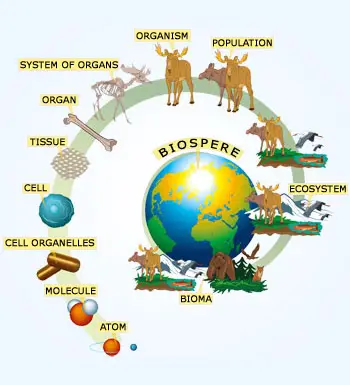There are different levels of organization in living systems, from molecules like DNA (genes) to the entire biosphere. When it comes to biology levels of organization they start from: genes → cell → organ → organism → species population → community → ecosystem → biome → biosphere
Living beings are extremely organized and structured, following a hierarchy on a scale from tiny to massive. The smallest and most basic unit of matter is the atom. It consists of a nucleus enclosed by electrons. Atoms create molecules. A molecule could be a chemical structure consisting of a minimum of 2 atoms joined by a chemical bond.
Many biologically vital molecules are macromolecules, large molecules typically formed by the combination of smaller units known as monomers. An example is DNA. Genes are made up of DNA. The gene is the basic physical and functional unit of heredity.
Some cells contain groups of macromolecules surrounded by membranes; these are called organelles. Organelles are small structures that are inside cells and perform specific functions.
All living things are made up of cells; The cell itself is the smallest basic structural and functional unit in living organisms. (This requirement is why viruses are not considered living: they are not made up of cells. To create new viruses, they must enter and hijack a living cell; only then can they obtain the materials they need to reproduce.) Some organisms are made of a single cell and others are multicellular.
Cells are divided into prokaryotes and eukaryotes. Prokaryotes are unicellular organisms that lack membrane-bound organelles and whose nuclei are not surrounded by nuclear membranes; In contrast, the cells of eukaryotes have membrane-bound organelles and nuclei.
In most multicellular organisms, cells associate to form tissues, which are groups of similar cells that perform the same function. Organs are groups of tissues grouped according to a common function. Organs are not only found in animals, but also in plants. An organ system is a higher organizational level consisting of functionally related organs.
For example, vertebrates have many organ systems, such as the circulatory system, which carries blood throughout the body and to and from the lungs; including organs such as the heart and blood vessels. Individual living beings are called organisms. For example, every tree in a forest is an organism. Unicellular prokaryotes and unicellular eukaryotes are also considered organisms and are commonly referred to as microorganisms.
Individuals of a species living in a particular area are collectively referred to as a population. The forest may include many white pine trees. All of these pine trees represent the population of white pine trees in that forest.
Different populations can live in the same area. The forest with pine trees consists of populations of flowering plants and also insects and microbial populations. A community is a set of populations inhabiting a particular area. For instance, all of the trees, flowers, insects, and other populations in a forest made up the forest’s community. The forest is an ecosystem.
An ecosystem consists of all living things in a given area along with the abiotic parts of that environment, such as nitrogen in the soil or rainwater. The highest level of organization, the biosphere is the collection of all ecosystems and represents the zones of life on earth. It includes land, water, and parts of the atmosphere.

Erzsebet Frey (Eli Frey) is an ecologist and online entrepreneur with a Master of Science in Ecology from the University of Belgrade. Originally from Serbia, she has lived in Sri Lanka since 2017. Eli has worked internationally in countries like Oman, Brazil, Germany, and Sri Lanka. In 2018, she expanded into SEO and blogging, completing courses from UC Davis and Edinburgh. Eli has founded multiple websites focused on biology, ecology, environmental science, sustainable and simple living, and outdoor activities. She enjoys creating nature and simple living videos on YouTube and participates in speleology, diving, and hiking.

